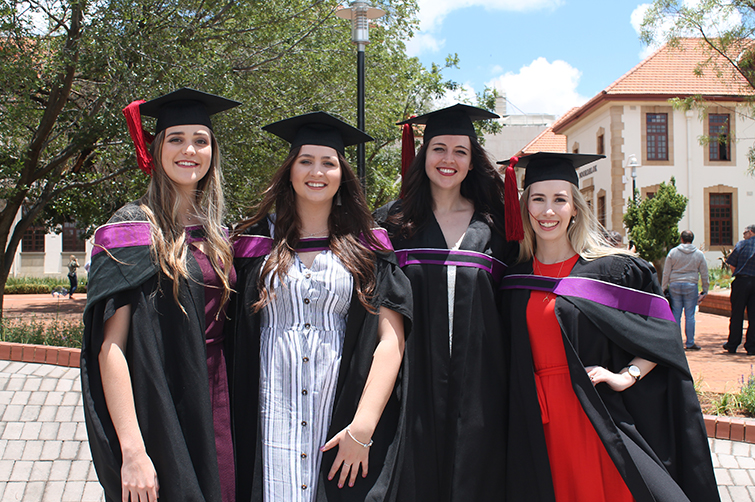12 December 2019
|
Story Xolisa Mnukwa
|
Photo Xolisa Mnukwa
 (From the left) Mia, Dahné, Chrisna, and Doré, who have been friends since Grade 8, pushed through the academic struggle and realised their dream of becoming doctors together in record time. #UFSGraduation2019
(From the left) Mia, Dahné, Chrisna, and Doré, who have been friends since Grade 8, pushed through the academic struggle and realised their dream of becoming doctors together in record time. #UFSGraduation2019
They have been friends since Grade eight, starting high school together at Hoër Meisieskool Oranje in Bloemfontein. More than a decade later, friends Dahné Beukes, Chrisna Goosen, Mia Vosloo, and Doré de Necker are still doing things together – this time adding the title of doctor to their names on the same day. The four friends graduated together at the 2019 December graduation ceremonies of the University of the Free State, obtaining their MB ChB qualifications.
A combination of emotions ranging from stress and frustration, to ultimate excitement and gratitude, with a lot of support from her family and close friends, is how Beukes described the six years it took to complete her degree. She described her future as a pool filled with opportunities that she hopes will eventually lead her to working abroad.
“The key to success is maintaining balance in life, and this can be achieved through your friendships,” Beukes explained the friendship she maintained with her fellow Hoër Meisieskool Oranje friends.
Beukes’ sentiments are echoed by Vosloo, who says she is grateful for being able to surround herself with people who share her values and beliefs and helped build her into the version of herself that she is today.
Vosloo will complete her medical internship at the Port Elizabeth Livingstone Hospital in 2020, and says she aspires to specialise in psychiatry and ultimately settle down and start a family.
“I believe it's good to be flexible and not have your mind set on something too specific, because things rarely go according to plan; so, I’m trying to enjoy the ride. As long as I can have a dog wherever life takes me, I'll probably be happy,” she reflected.
Newlywed Goosen, now Chrisna Krügel, looks forward to completing her medical internship alongside her husband, Tinus Krügel, who also obtained his degree during the December graduation ceremonies.
She explained that studying medicine was challenging, and that she sometimes experienced difficulty maintaining a lot of her friendships, resulting in her keeping only her closest friends.
Goosen implores the incoming batch of medical students to remain humble and to make full use of the opportunities the university offers them in order to make a success of their studies.
De Necker also offers advice for incoming first-year medical students.
“Study hard, always have the bigger picture in mind when things get rough, and make friends in your classes early on, as they will be walking the academic road with you for a couple of years.”
“It's been amazing to see my fellow high school classmates growing through these years, all three of them have shown great character,” she explained.